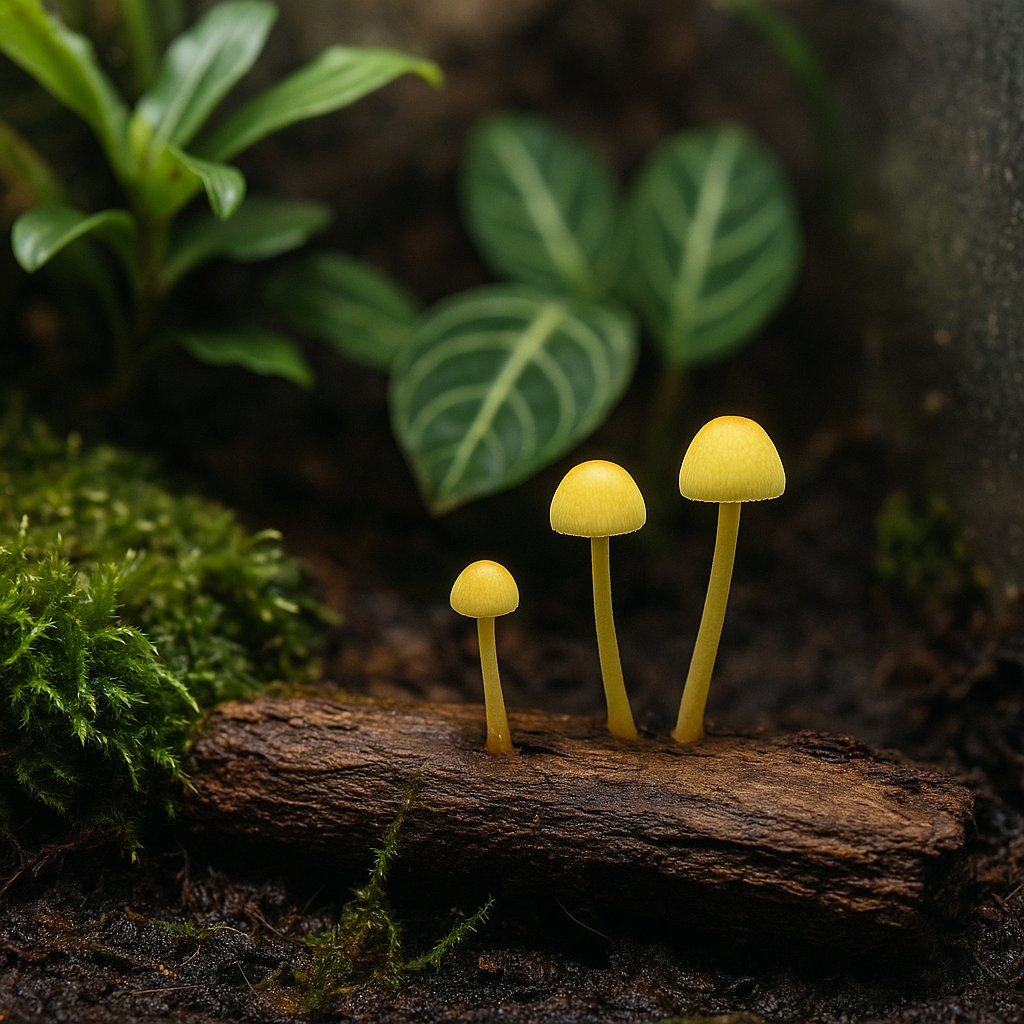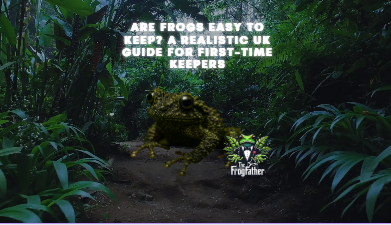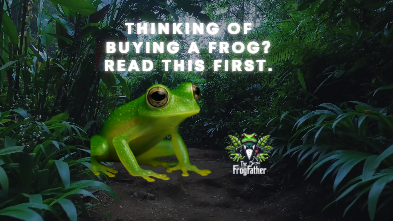You open your vivarium one morning and spot a cluster of tiny mushrooms sprouting from your substrate or wood. They weren’t there yesterday — and now they’re everywhere. If you keep dart frogs or other amphibians, your first thought might be: “Are mushrooms dangerous?”
Good news — in most cases, mushrooms are completely harmless and are actually a sign of a healthy, thriving bioactive ecosystem. But, as with all things in vivarium keeping, it depends on the species, conditions, and balance inside your tank. Let’s break down what’s really happening beneath the surface.
🌿 What Mushrooms Mean in a Bioactive Vivarium
Mushrooms are the visible fruiting bodies of fungi that live in your substrate and wood. Their presence usually means your enclosure is cycling nutrients properly — the fungi are decomposing organic matter, feeding your microfauna, and releasing nutrients for plants.
In other words, if mushrooms are growing, your vivarium is alive and working exactly as it should. The fungi themselves are a natural part of rainforest floor ecosystems, where dart frogs, isopods, and springtails all coexist with hundreds of fungal species.
🧬 Are Mushrooms Dangerous to Frogs?
In nearly all cases, no — common terrarium mushrooms are not toxic or harmful to frogs, isopods, or other inhabitants. They appear temporarily when humidity, temperature, and nutrients align, then vanish within days as the microfauna consume them.
However, there are a few considerations to keep in mind:
- Do not allow wild-collected mushrooms or unidentified fungi from outside to enter your tank — these could carry spores or toxins not safe for enclosed systems.
- Don’t feed mushrooms directly to frogs. While most species ignore them, dart frogs may occasionally sit on or touch them — that’s perfectly fine.
- Avoid chemical fungicides or cleaning sprays — these can do more harm than the mushrooms themselves.
If you’re ever unsure, gently remove the fruiting bodies but leave the mycelium (the white web underground) intact — it’s part of your bioactive balance.
🍂 Why Mushrooms Grow in Vivariums
Mushroom spores are everywhere — they arrive on plants, substrate, or décor like cork bark. Once the right combination of moisture and organic material exists, they fruit naturally. This is especially common in new setups during the first few months, when the substrate is rich and the microfauna are still stabilising.
Typical triggers for mushrooms include:
- High humidity (80–100%)
- Fresh wood or leaf litter
- Low airflow and consistent warmth
- Natural spore introduction from plants or moss
🍄 Common Types of Mushrooms in Vivariums
Most vivarium mushrooms are tiny, fast-growing species of decomposers such as Coprinellus (inky caps), Mycena, or Leucocoprinus (the small yellow mushrooms often seen in terrariums). None of these are toxic to frogs in small numbers.
You may also notice delicate white “pin” fungi or fuzzy mats — these are harmless mould stages of the same fungal life cycle. As long as your springtails and isopods are active, they’ll handle them naturally.
💨 When Mushrooms Might Indicate a Problem
While mushrooms themselves are harmless, a sudden explosion of fungal growth can signal an imbalance:
- Overly damp substrate without airflow
- Too much decaying organic matter
- Low microfauna population
- Old wood that’s breaking down faster than usual
If you’re seeing constant regrowth or foul odours, it’s time to increase ventilation and check substrate drainage. The 3D-printed vivariums with angled vents are ideal for reducing stagnant air while keeping humidity stable.
🧹 How to Remove Mushrooms Safely
You don’t need to remove every mushroom, but if they’re blocking plants or you simply prefer a tidier look, do this:
- Gently twist and lift the mushroom at the base — avoid breaking it off halfway.
- Remove any leftover stem and surrounding substrate if it’s mushy.
- Dispose of the mushrooms outside (not in the vivarium bin).
- Check the area for airflow and add a small vent or reduce misting slightly.
Within a week, your microfauna should re-balance and fungal growth will slow naturally.
🌱 Should You Try to Prevent Mushrooms?
Not really. The presence of mushrooms is part of a healthy, mature bioactive ecosystem. Instead of fighting them, focus on balance — good airflow, a stable clean-up crew, and steady humidity.
Preventive tips include:
- Rinse new décor and plants before adding them.
- Quarantine plants (see our guide) to reduce spores and pests.
- Use varied leaf litter to keep fungal diversity stable.
- Maintain a healthy springtail population with a Springtail Collection Riser.
✅ Final Thoughts
Mushrooms in your vivarium aren’t invaders — they’re nature doing its job. They break down waste, feed your microfauna, and indicate a living, breathing ecosystem. Unless they’re overwhelming or rotting, they’re safe for frogs and invertebrates.
So next time you spot a little fungus popping up, take it as a sign that your enclosure is working beautifully. A thriving bioactive setup will always have a few surprises — and mushrooms are one of the good ones. 🍄
❓ Frequently Asked Questions
Are mushrooms harmful to dart frogs or other amphibians?
No — the mushrooms that appear naturally in vivariums are almost always harmless. They’re part of the fungal decomposition cycle that keeps your substrate alive. Frogs may occasionally sit on them, but they don’t eat them and are not affected by them.
Can I leave mushrooms growing in my vivarium?
Yes, you can. Mushrooms usually appear for a few days and then disappear as your clean-up crew consumes them. If you prefer a tidier look, simply twist and remove the fruiting body, but leave the mycelium below the surface intact.
Why do mushrooms suddenly appear in my tank?
Mushroom spores exist in almost all organic matter — wood, soil, and plants. When humidity, temperature, and nutrients are ideal, they fruit naturally. This is especially common in new bioactive setups or after adding fresh wood or leaf litter.
Can mushrooms indicate a problem with my vivarium?
Occasional mushrooms are a good sign, but constant growth might mean the substrate is too damp or lacks airflow. Check ventilation, reduce misting slightly, and make sure your clean-up crew is active.
Should I try to kill or prevent mushrooms?
No — don’t use fungicides or cleaning chemicals in a bioactive setup. These will harm your frogs and microfauna. Instead, control humidity naturally, increase ventilation, and keep your substrate balanced.
Are all mushrooms safe for terrariums?
The ones that appear from vivarium materials are safe, but never add mushrooms or fungi collected from outside. Wild species can carry spores or toxins unsuitable for closed ecosystems.
Do mushrooms compete with plants for nutrients?
Only very slightly. Mushrooms mainly break down decaying organic matter, releasing nutrients that plants and microfauna then use. Their presence actually supports long-term substrate health.



